According to the data based on reports in local and national newspapers and news agencies, a compilation made by bianet revealed that men killed at least 281 women, raped/attempted to rape 109 women and teenager girls, left 560 women injured and sexually harassed 140 women and teenager girls.
In 2013, men killed 214 women and 10 children, raped 167 women and teenager girls/ attempted to rape, used violence against 241 women and teenager girls, harassed 161 women and teenager girls.
Infographics: 2013 male violence
Murder

Men killed 281 women in 2014. Compared with 2013, murders rose by 31 percent. The distribution of murders according to years is as follows: 271 in 2010, 257 in 2011, 165 in 2012, 214 in 2013, and 1,134 in the past 5 years.
20.64 percent of women were killed for seeking a divorce/breakup: At least 58 slain women declared that they wanted to divorce from husband / breakup from lover. They also either filed for divorce or left their partner to live another apartment.
8.9 percent of women were killed due to lack of state security: 25 women applied to authorities for restraint order or filed a complaint on violence or death threats.
3.9 percent of murder perpetrators previously faced trial for violence charges and released within an acquittal, amnesty or judiciary control measures: 11 women were murdered by unpunished aggressors.
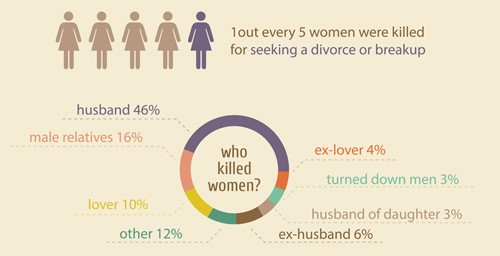
45.9 percent of women were killed by their husbands, 16 percent by their male relatives (brother, son, father, cousin, etc), 9.96 percent by their lovers, 9.96 by their ex-partners (ex-lover, ex-lover, ex-fiancee). Murder perpetrator men were identified as husband (129), lover (28), ex-lover (11), ex-husband (16), fiancee (4), ex-fiancee (1), son-in-law (8), ex-son-in-law (1), man with turned down proposal (8), harasser (2), brother (14), son (8), father (7), stepfather (1), other male relative (16), neighbor (5), customer (1), friend/male acquaintance (5), friend’s son (1), man who quarreled with husband (4), boss (1), co-worker (1), mother’s lover (2), stranger (2). 5 murder suspects were not caught.
While 59 percent of murders were perpetrated with firearms, 29.89 percent were killed with a knife, axe or another sharp object, 5.34 percent by strangling, 3.56 by beating. Murders were committed by the following methods: pistol (101), rifle (65), sharp object (84), beating (10), strangling (15), electricity (1), torture (1), pushing from a high place (3), undisclosed (1).
In 2014, 3 women were murdered outside courthouse and 1 woman outside prison.
Following the murders, 12.48 percent of male perpetrators committed suicide, 3.9 percent attempted to do so, 8.9 percent surrendered. 35 murderers committed suicide, 11 attempted to commit suicide, 25 surrendered.
Rape

In 2014, men raped/attempted to rape 109 women and teenager girls.
32.11 percent of rape victims were children. In 2014, 35 teenager girls between 12 and 17 were raped in Turkey.
12.84 percent of women were non-Turkish nationals: 14 women with tourist, refugee or worker background were raped in 2014.
4.5 percent of rape victim women and teenager girls had disabilities: 5 women with disabilities were raped and 1 minor was forced to prostitution.
In 2014, 29.36 percent of rape (32) cases that appeared in the media involved forced prostitutions.
While 56.8 percent of rapists were stranger to their victims, 11.93 percent were women’s current or former partners (husband, ex-husband, lover, ex-lover, fiancee) and 11.93 percent were friend/acquaintance.
Rape perpetrator men were identified as stranger (62), friend/acquaintance (13), ex/new partner (13 with 5 lovers, 5 ex-lovers, 1 husband, 1 ex-husband, 1 fiancee), co-worker (2), boss (1), relative (7), server (driver, hotel staff, etc) (4), healthcare professional (2), village guard (1), policemen (1), teacher (1), turned down man (1), sex worker’s customer (1).
Rapes were committed in the following venues: Abduction venues (44 percent, 48 cases), apartment (25.69 percent, 28 cases), on the street (17.43 percent 19 cases) in the vehicle (4.59 percent, 5 cases), office (3 cases), hospital (2 cases), apartment building entrance (1 case) hotel (1), refugee camp (1), unspecified (1 case).
Battery/Assault
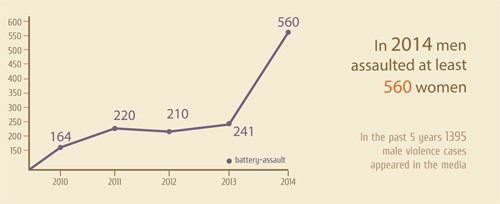
In 2014, men battered/assaulted 560 women.
12.85 percent of women were assaulted for seeking a divorce.
4.5 percent of women were subjected to violence even though they made the complaint applications according to Law No 6284.
Women were subject to violence mostly by partners (66.96 percent in total including husband, lover, fiancee), ex-partners (7.85 percent) and male relatives (10.5 percent).
Violence perpetrators included: husband (333), lover (41), fiancee (1), ex-husband (32), ex-lover (8), ex-fiancee (4), father (18), brother (8), son (23), other male relative (10), friend/acquaintance (6), son-in-law (6), ex-son-in-law (3), server (driver, server, etc) (9), client (6), co-worker (8), tenant (1), ex-partners of female acquaintances (daughter, friend, mother, etc), partners of female acquaintances (5), neighbor (8), neighbor administrator (1), armed organization (1), boss (1), police officer (1), turned down man (2), stranger (18).
Most violence cases occurred in the form of battery (69.82 percent), with a knife (16 percent), firearm (8.9 percent). The number of cases was as follows: battery (391), by knife (90), firearm (50), running over with/pushing away from a car (4), pushing away from balcony (1), attempted strangling (1), assault with axe/hammer (2), grenade-throwing (1), molotov cocktail throwing (2), demolishing house (1), arson (1), throwing acid (2), threatening with a pistol (2), burning with boiled water or gasoline (6).
Harassment
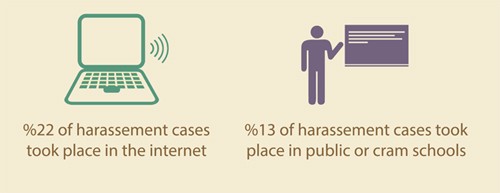
In 2014, men sexually harassed 140 women and teenager girls. Among the cases where victims’ ages were revealed, 67 percent were identified as teenager girls between 10 to 17 years old.
While 65.7 percent of cases were perpetrated by stranger men, 10 percent of perpetrators were teachers. Harassment perpetrators were identified as stranger (92), teacher (14), friend/acquaintance (11), relative (6), boss (4), ex-husband or divorce-sought husband (4), servers including driver or local business worker, neighbor (3), lover (2).
Harassment venues were listed as follows: on the street (40 percent, 56 cases), online (22 percent, 31 cases), school (12.85 percent, 18 cases), apartment (14 cases), transport (7 cases), over the phone (4 cases), office (3 cases), hospital (2 cases), shop (2 cases), private vehicle (2 cases), elevator (1 case).
Regional distribution
* These statistics are based on the violence cases that appeared in the media in 2014. Male violence cases throughout the country do not always attract media coverage. Therefore, this study only reflects the regional distribution of male violence cases that “managed to be newsworthy”.
The ratio of male violence cases to regional population of women was indexed depending on the 2013 census statistics by Statistics Institute of Turkey. In 2014, 1,090 male violence cases of murder, attempted murder, harassment, sexual violence, rape and assault appeared in the media. Among these cases, the location was identified in 1,088 cases. According to the number of cases that appeared in the media, most cases were reported from Marmara Region.
The percentages of cases according to regions was as follows: Marmara (27%), Black Sea (18%), Mediterranean (17%), Central Anatolia (14%), Aegean (13%), Southeastern (7%), Eastern (5%).
According to that, the distribution of male violence cases according to regions was as follows: Marmara (294), Black Sea (198), Mediterranean (188), Central Anatolia (147), Aegean (137), Southeastern (75), Eastern (49). (2 location of 2 cases were unspecified.)
On the other hand, Black Sea Region rated as the first region when male violence cases with media coverage were rationed to regional women population. Black Sea region was followed by Mediterranean, Aegean, Marmara, Central Anatolia, Southeastern and Eastern regions.
Regarding the regional density of male violence cases, Assistant Professor at Koç University Civil Engineering prepared the following index:
(When cases are indexed on 0 to 10 points)
* First rank with 10 points: Black Sea region with highest ratio in male violence cases. (The sum of regional violence cases with media coverage divided by regional women population is 52.0)
* Second rank with 7.4 points: Mediterranean region (The sum of regional violence cases with media coverage divided by regional women population is 38.7)
* Third rank with 5.3 points: Aegean region. (The sum of regional violence cases with media coverage divided by regional women population is 27.7)
* Forth rank with4.9 points: Marmara region. (The sum of regional violence cases with media coverage divided by regional women population is 25.5)
* Fifth rank with 4.6 points: Central Anatolia region. (The sum of regional violence cases with media coverage divided by regional women population is 23.9)
* Sixth rank with 3.8 points: Southeastern Anatolia region. (The sum of regional violence cases with media coverage divided by regional women population is 19,8)
* Last rank with 3 points: Eastern Anatolia region. (The sum of regional violence cases with media coverage divided by regional women population is 15.7)
Turkey average turned out 5.5 in the 10 point index. (The sum of country-wide violence cases with media coverage divided by total women population is 5.5) (ÇT/BM)
* Click here to read the article in Turkish.





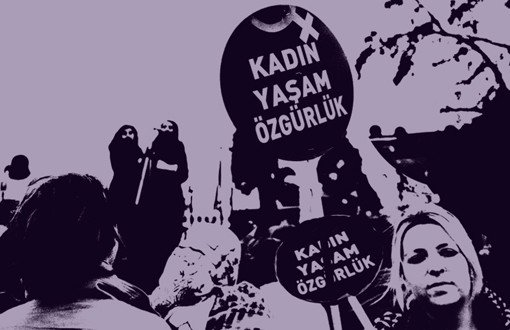
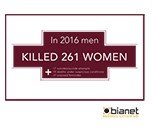
.jpg)



